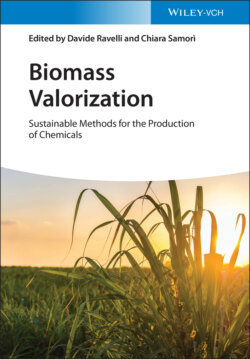Читать книгу Biomass Valorization - Группа авторов - Страница 12
1.1 Introduction
ОглавлениеChemistry is a fundamental part of everything around us. Nature is largely responsible for all of the chemistry that occurs and has been so from the dawn of time. However, societal advances and technological developments in recent years have allowed us to contribute far more chemistry than in the past. Quality‐of‐life improvements for major parts of the world with better food distribution, clothing, technological devices, and medical treatments have required the chemistry to progress further with detrimental unknown effects on the environment. Policies and scientists worldwide are now striving toward the development of a truly sustainable society, culminating into the implementation of the UN's 17 Sustainable Development Goals that tackle various issues including infrastructures, education, equality, peace, and environmental protection [1]. In the active search for solutions, biomass valorization has emerged as the most viable option for a more sustainable chemical industry.
The impact that sustainability could have on the chemical industry is best reflected in the magnitude of the chemical industry itself. Today, the chemical industry generates approximately $4 trillion in global sales with the production of more than 95% of all commodities [2]. One of the biggest turning points in the chemical industry, and what arguably led it to such heights, was the advent of catalytic cracking in the nineteenth century for the refining of fossil resources. Catalytic cracking allowed for most of the products we use daily to be easily sourced from petroleum [3]. Biomass valorization processes were also being explored around the same time. However, the complex nature of biomass and the wide availability of fossil resources gained all of society's attention on the use of the latter [4]. As such, petroleum processes have been the major focus of scientists and engineers for the past two centuries. Although significant developments have been achieved considering this with higher resource efficiency and cleaner technologies, the resulting environmental concerns driven by the emissions and spills have led much attention back to renewable processes such as biomass valorization.
Biomass valorization and more sustainable practices are important steps for overturning the “disposable society” mindset where resources are viewed as infinite, cheap, and harmless. One of the most straightforward examples of this can be seen with plastic. Advances in chemistry not only created plastics but also helped notice the alarming consequences.
Plastics were developed in conjunction with the advent of petroleum processes. Plastic products possess desirable characteristics (lightweight, durable, etc.) that allow for endless applications at a low manufacturing cost. Plastics found their way into daily use with things such as clothing and packaging. However, we were unequipped to properly handle this new technology. The characteristics that make plastic so appealing for a wide variety of applications (i.e. durable and heat resistant) are the same that make plastic so difficult to deal with. Its inherent non‐degradability, along with extremely careless handling and littering, created a plastic waste crisis with the now widespread problem of microplastics in our oceans [5,6]. Biomass is a more attractive feedstock that can create bio‐based and/or biodegradable plastics to help overturn the drastic impact from petroleum‐based products. Much initial research has focused on using biomass for drop‐in solutions, i.e. plastics with the same composition and properties as the traditional ones (e.g. polyethylene [PE] and polyethylene terephthalate [PET]). However, the process chemistry limits the efficiency to sugars. On the other hand, other bio‐based plastics with new properties have been developed, e.g. polyethylene furanoate (PEF) or poly‐lactate (PLA). The former is a durable plastic based on furan and the latter a compostable plastic. Developing bio‐based plastics that are also biodegradable – a fundamental challenge in biomass valorization – can ensure a higher sustainability at the waste management stage, as their waste is less dangerous to animals and humans (microplastics, trapped in fishing nets). However, differentiation in the lifetimes of plastics will also require the development of durable bioplastics.
Accumulating plastic waste is just one of the many concerns that is helping to drive sustainable practices forward. Other concerns from the fossil‐driven industrial revolution include the following:
Irreversible depletion of fossil fuels (i.e. oil and gas) and their detrimental environmental issues [7,8].
Higher average temperatures and aggravation of weather conditions worldwide (e.g. heavier rains) from an increase of greenhouse gases and record levels of CO2 in the atmosphere [9].
Global population growth (>9 billion projected by 2050) leading to higher energy, food, and chemical demands [10].
These concerns require a sustainable chemical industry that embraces the concepts of green chemistry [11], circular [12] and low‐carbon economies [13], and high resource efficiency [14]. As such, biomass valorization and conversion of renewable feedstocks through green processes are advancing to fully shift toward a safer and sustainable chemical industry.
